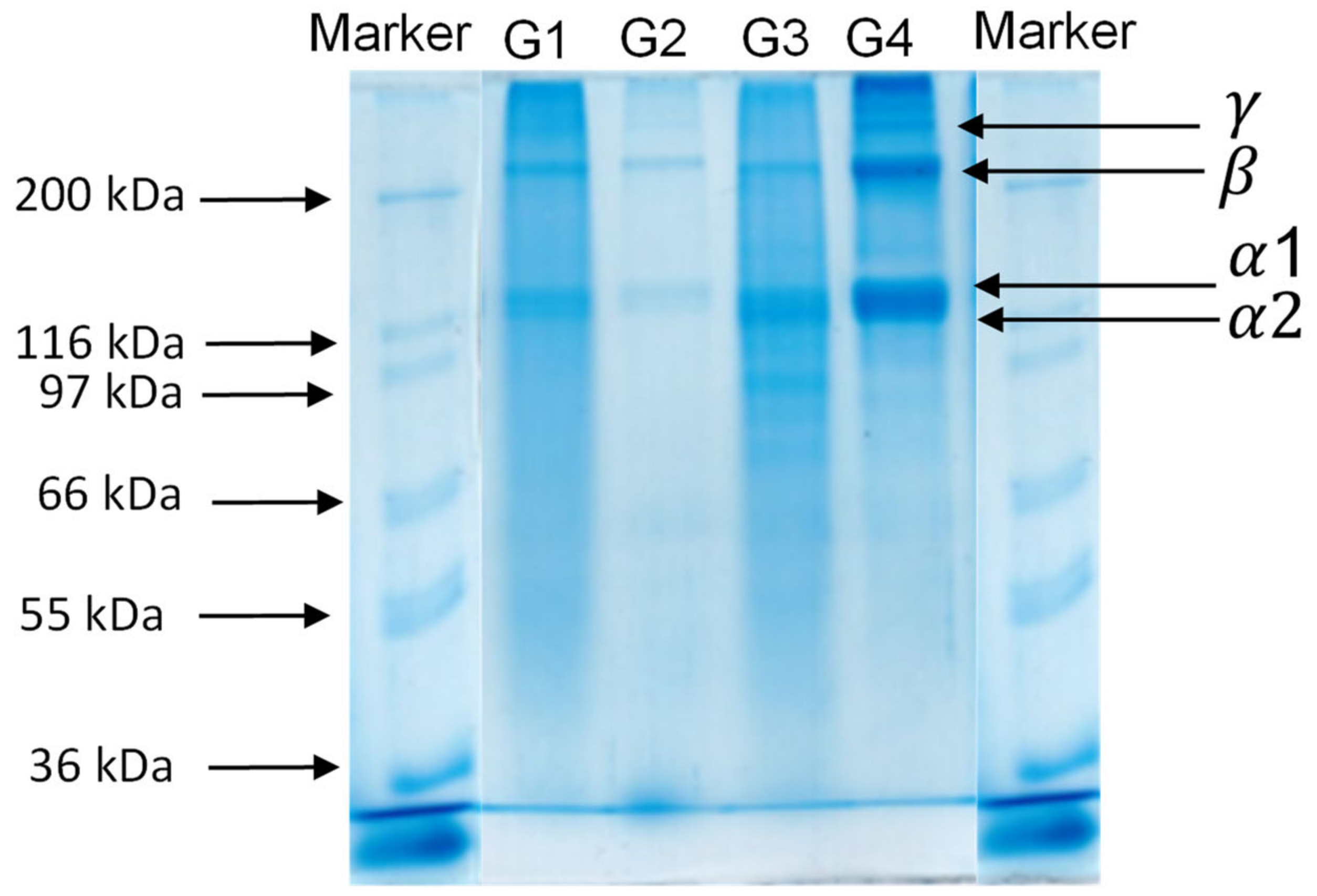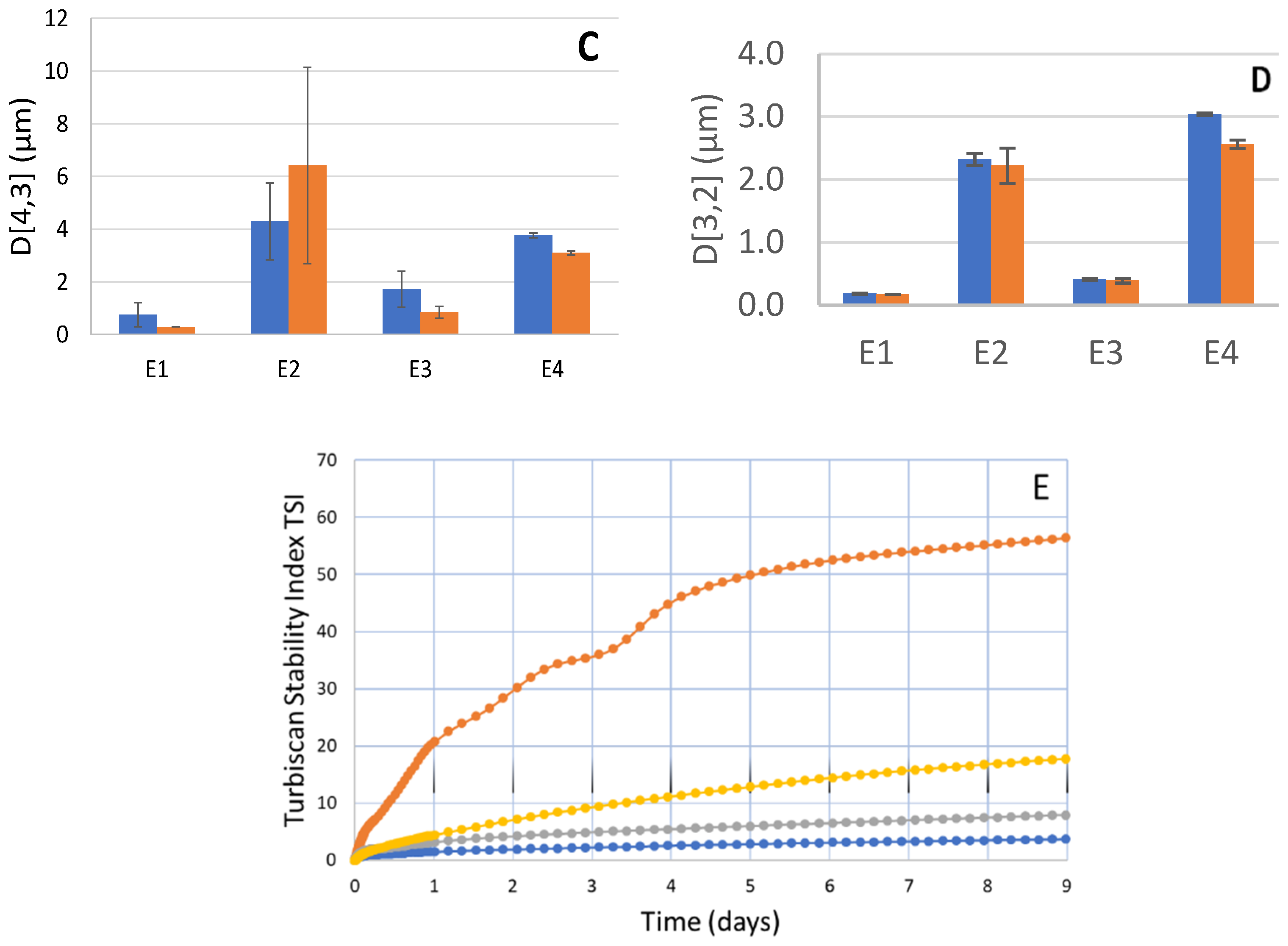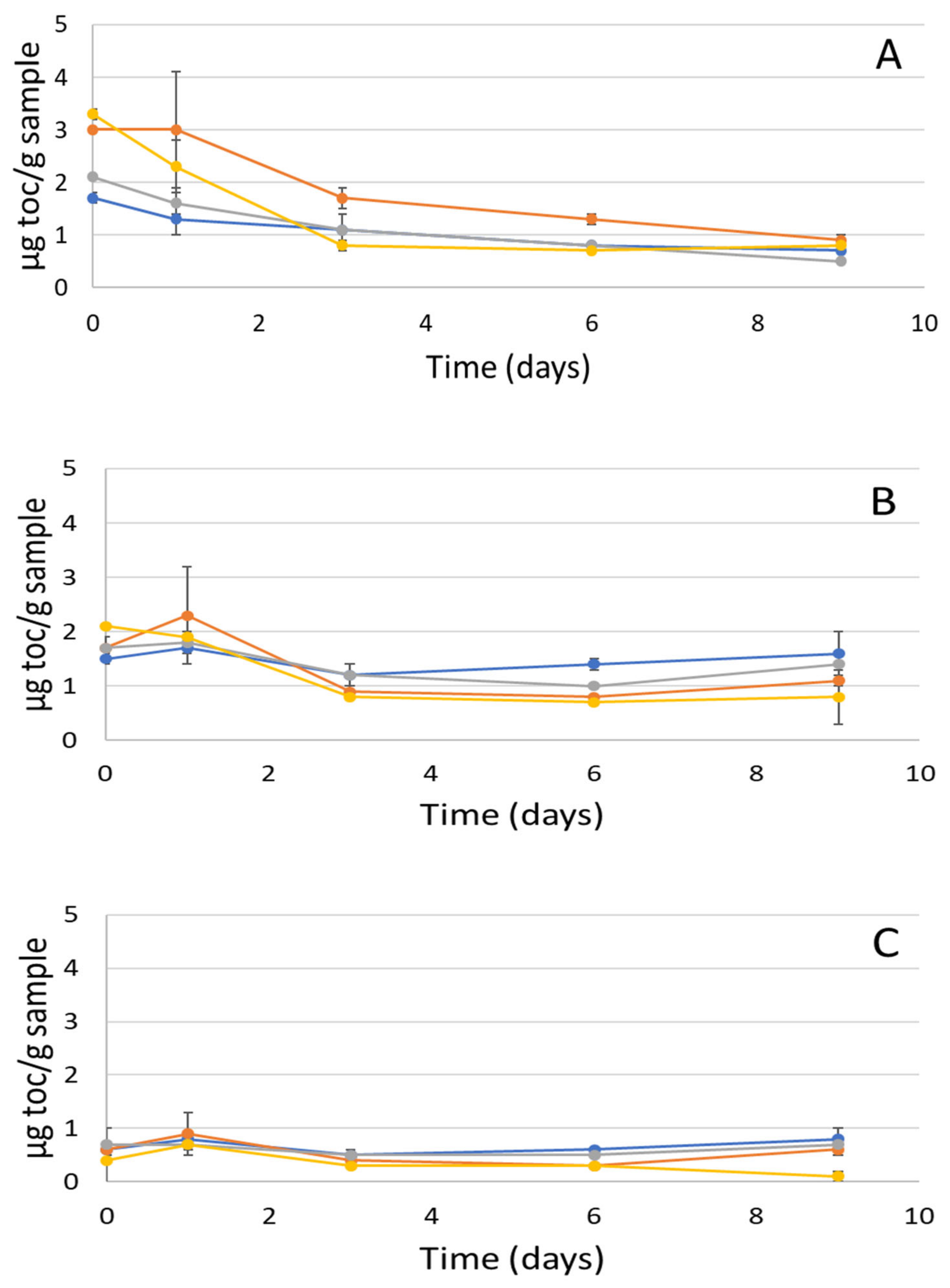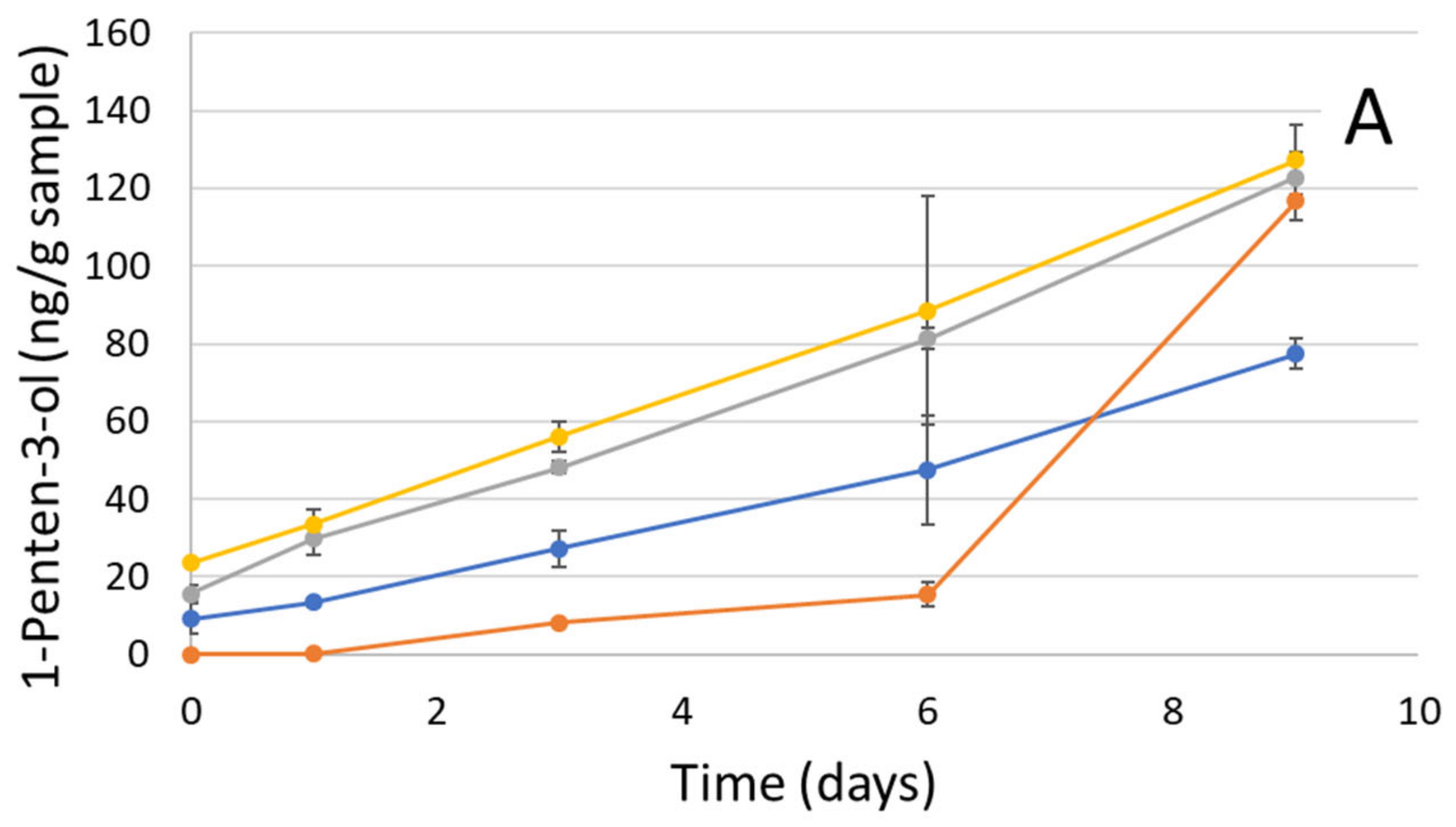Gelatin from Saithe (Pollachius virens) Skin: Biochemical Characterization and Oxidative Stability in O/W Emulsions
Abstract
1. Introduction
2. Results
2.1. Physico-Chemical Properties and Mineral Composition
2.2. SDS-PAGE
2.3. Amino Acid Composition
2.4. FTIR
2.5. Thermal Properties (DSC)
2.6. O/W Emulsions: Dh, ζ-Potential, and Physical Stability
2.7. Oxidative Stability
2.7.1. Peroxide Value
2.7.2. Tocopherol Consumption
2.7.3. Secondary Volatile Oxidative Stability
3. Discussion
4. Materials and Methods
4.1. Raw Material
4.2. Chemical Composition
4.3. Determination of Gel Strengths (Bloom Strength)
4.4. Mineral Composition
4.5. Electrophoretic Study (SDS-PAGE)
4.6. Amino Acid Composition
4.7. Fourier Transform Infrared (FTIR) Spectroscopy
4.8. Differential Scanning Calorimetry (DSC)
4.9. Preparation and Physical Stability of O/W Emulsions
4.9.1. Hydrodynamic Diameter by Dynamic Light Scattering (DLS)
4.9.2. ζ-Potential Measurements
4.9.3. Droplet Size Distribution
4.10. Oxidative Stability
4.10.1. Peroxide Value
4.10.2. Tocopherol Consumption
4.10.3. Secondary Volatile Oxidation Products Using Dynamic Headspace GC-MS
4.11. Statistical Analysis
Supplementary Materials
Author Contributions
Funding
Institutional Review Board Statement
Informed Consent Statement
Data Availability Statement
Acknowledgments
Conflicts of Interest
References
- McClements, D.J. Food Emulsions—Principles, Practices, and Techniques, 3rd ed.; CRC Press: Boca Raton, FL, USA, 2016. [Google Scholar]
- García-Moreno, P.J.; Guadix, A.; Guadix, E.M.; Jacobsen, C. Physical and oxidative stability of fish oil-in-water emulsions stabilized with fish protein hydrolysates. Food Chem. 2016, 203, 124–135. [Google Scholar] [CrossRef] [PubMed]
- Berton-Carabin, C.C.; Ropers, M.-H.; Genot, C. Lipid Oxidation in Oil-in-Water Emulsions: Involvement of the Interfacial Layer. Compr. Rev. Food Sci. Food Saf. 2014, 13, 945–977. [Google Scholar] [CrossRef]
- Shavandi, A.; Hou, Y.; Carne, A.; McConnell, M.; din Bekhit, A.E. Marine Waste Utilization as a Source of Functional and Health Compounds, 1st ed.; Elsevier Inc.: Amsterdam, The Netherlands, 2019. [Google Scholar] [CrossRef]
- Karim, A.A.; Bhat, R. Fish gelatin: Properties, challenges, and prospects as an alternative to mammalian gelatins. Food Hydrocoll. 2009, 23, 563–576. [Google Scholar] [CrossRef]
- Yang, H.; Wang, H.; Huang, M.; Cao, G.; Tao, F.; Shen, Q.; Zhou, G.; Yang, H. Repurposing fish waste into gelatin as a potential alternative for mammalian sources: A review. Compr. Rev. Food Sci. Food Saf. 2022, 21, 942–963. [Google Scholar] [CrossRef] [PubMed]
- Henriet, P.; Jessen, F.; Vall-Llosera, M.; Marie, R.; Jahromi, M.; Mohammadifar, M.A.; Stampe-Villadsen, H.L.; Casanova, F. Physical Stability of Oil-In-Water Emulsion Stabilized by Gelatin from Saithe (Pollachius virens) Skin. Foods 2020, 9, 1718. [Google Scholar] [CrossRef]
- Alfaro, A.T.; Balbinot, E.; Weber, C.I.; Tonial, I.B. Machado-Lunkes, Fish Gelatin: Characteristics, Functional Properties, Applications and Future Potentials. Food Eng. Rev. 2014, 7, 33–44. [Google Scholar] [CrossRef]
- Songchotikunpan, P.; Tattiyakul, J.; Supaphol, P. Extraction and electrospinning of gelatin from fish skin. Int. J. Biol. Macromol. 2008, 42, 247–255. [Google Scholar] [CrossRef]
- Jamilah, B.; Harvinder, K.G. Properties of gelatins from skins of fish—Black tilapia (Oreochromis mossambicus) and red tilapia (Oreochromis nilotica). Food Chem. 2002, 77, 81–84. [Google Scholar] [CrossRef]
- Gómez-Guillén, M.; Turnay, J.; Fernández-Dıáz, M.D.; Ulmo, N.; Lizarbe, M.; Montero, P. Structural and physical properties of gelatin extracted from different marine species: A comparative study. Food Hydrocoll. 2002, 16, 25–34. [Google Scholar] [CrossRef]
- Muyonga, J.H.; Cole, C.G.B.; Duodu, K.G. Extraction and physico-chemical characterisation of Nile perch (Lates niloticus) skin and bone gelatin. Food Hydrocoll. 2004, 18, 581–592. [Google Scholar] [CrossRef]
- Casanova, F.; Mohammadifar, M.A.; Jahromi, M.; Petersen, H.O.; Sloth, J.J.; Eybye, K.L.; Kobbelgaard, S.; Jakobsen, G.; Jessen, F. Physico-chemical, structural and techno-functional properties of gelatin from saithe (Pollachius virens) skin. Int. J. Biol. Macromol. 2020, 156, 918–927. [Google Scholar] [CrossRef]
- Sila, A.; Martinez-Alvarez, O.; Krichen, F.; Gómez-Guillén, M.; Bougatef, A. Gelatin prepared from European eel (Anguilla anguilla) skin: Physicochemical, textural, viscoelastic and surface properties. Colloids Surfaces Physicochem. Eng. Asp. 2017, 529, 643–650. [Google Scholar] [CrossRef]
- Doyle, B.B.; Bendit, E.G.; Blout, E.R. Infrared spectroscopy of collagen and collagen-like polypeptides. Biopolymers 1975, 14, 937–957. [Google Scholar] [CrossRef]
- Muyonga, J.H.; Cole, C.G.B.; Duodu, K.G. Characterisation of acid soluble collagen from skins of young and adult Nile perch (Lates niloticus). Food Chem. 2004, 85, 81–89. [Google Scholar] [CrossRef]
- Hashim, D.; Man, Y.C.; Norakasha, R.; Shuhaimi, M.; Salmah, Y.; Syahariza, Z. Potential use of Fourier transform infrared spectroscopy for differentiation of bovine and porcine gelatins. Food Chem. 2010, 118, 856–860. [Google Scholar] [CrossRef]
- Benjakul, S.; Oungbho, K.; Visessanguan, W.; Thiansilakul, Y.; Roytrakul, S. Characteristics of gelatin from the skins of bigeye snapper, Priacanthus tayenus and Priacanthus macracanthus. Food Chem. 2009, 116, 445–451. [Google Scholar] [CrossRef]
- Nagarajan, M.; Benjakul, S.; Prodpran, T.; Songtipya, P.; Kishimura, H. Characteristics and functional properties of gelatin from splendid squid (Loligo formosana) skin as affected by extraction temperatures. Food Hydrocoll. 2012, 29, 389–397. [Google Scholar] [CrossRef]
- Mukherjee, I.; Rosolen, M. Thermal transitions of gelatin evaluated using DSC sample pans of various seal integrities. J. Therm. Anal. 2013, 114, 1161–1166. [Google Scholar] [CrossRef]
- Rahman, M.S.; Al-Saidi, G.S.; Guizani, N. Thermal characterisation of gelatin extracted from yellowfin tuna skin and commercial mammalian gelatin. Food Chem. 2008, 108, 472–481. [Google Scholar] [CrossRef]
- Al-Saidi, G.; Rahman, M.S.; Al-Alawi, A.; Guizani, N. Thermal characteristics of gelatin extracted from shaari fish skin. J. Therm. Anal. 2010, 104, 593–603. [Google Scholar] [CrossRef]
- Giménez, B.; Turnay, J.; Lizarbe, M.A.; Montero, P.; Gómez-Guillén, M.C. Use of lactic acid for extraction of fish skin gelatin. Food Hydrocoll. 2005, 19, 941–950. [Google Scholar] [CrossRef]
- Safandowska, M.; Pietrucha, K. Effect of fish collagen modification on its thermal and rheological properties. Int. J. Biol. Macromol. 2013, 53, 32–37. [Google Scholar] [CrossRef] [PubMed]
- Taherian, A.R.; Britten, M.; Sabik, H.; Fustier, P. Ability of whey protein isolate and/or fish gelatin to inhibit physical separation and lipid oxidation in fish oil-in-water beverage emulsion. Food Hydrocoll. 2011, 25, 868–878. [Google Scholar] [CrossRef]
- Kumar, N.; Gaur, T.; Mandal, A. Characterization of SPN Pickering emulsions for application in enhanced oil recovery. J. Ind. Eng. Chem. 2017, 54, 304–315. [Google Scholar] [CrossRef]
- Comunian, T.A.; Ravanfar, R.; Selig, M.J.; Abbaspourrad, A. Influence of the protein type on the stability of fish oil in water emulsion obtained by glass microfluidic device. Food Hydrocoll. 2018, 77, 96–106. [Google Scholar] [CrossRef]
- Haahr, A.; Jacobsen, C. Emulsifier type, metal chelation and pH affect oxidative stability of n-3-enriched emulsions. Eur. J. Lipid Sci. Technol. 2008, 110, 949–961. [Google Scholar] [CrossRef]
- Ghelichi, S.; Sørensen, A.-D.M.; Moreno, P.J.G.; Hajfathalian, M.; Jacobsen, C. Physical and oxidative stability of fish oil-in-water emulsions fortified with enzymatic hydrolysates from common carp (Cyprinus carpio) roe. Food Chem. 2017, 237, 1048–1057. [Google Scholar] [CrossRef][Green Version]
- Ries, D.; Ye, A.; Haisman, D.; Singh, H. Antioxidant properties of caseins and whey proteins in model oil-in-water emulsions. Int. Dairy J. 2010, 20, 72–78. [Google Scholar] [CrossRef]
- Lethuaut, L.; Métro, F.; Genot, C. Effect of droplet size on lipid oxidation rates of oil-in-water emulsions stabilized by protein. J. Am. Oil Chem. Soc. 2002, 79, 425–430. [Google Scholar] [CrossRef]
- Singh, P.; Benjakul, S.; Maqsood, S.; Kishimura, H. Isolation and characterisation of collagen extracted from the skin of striped catfish (Pangasianodon hypophthalmus). Food Chem. 2011, 124, 97–105. [Google Scholar] [CrossRef]
- Cunniff, P.; Washington, D.; AOAC. Official Methods of Analysis of AOAC international. J. AOAC Int. 1997, 80, 127A. [Google Scholar]
- Dumas, J.B.A. Procedes de l’analyse organique. Ann. Chim. Phys. 1831, T47, 198–213. [Google Scholar]
- Wainewright, F.W. Physical test for gelatin and gelatin products. In The Science and Technology of Gelatin; Ward, A.G., Ed.; Academic Press: London, UK, 1977; pp. 507–531. [Google Scholar]
- Bhat, R.; Karim, A. Ultraviolet irradiation improves gel strength of fish gelatin. Food Chem. 2009, 113, 1160–1164. [Google Scholar] [CrossRef]
- Laemmli, U.K. Cleavage of Structural Proteins during the Assembly of the Head of Bacteriophage T4. Nature 1970, 227, 680–685. [Google Scholar] [CrossRef]
- Rabilloud, S.; Charmont, T. Detection of proteins on two-dimensional electrophoresis gels. In Proteome Res Two-Dimensional Gel Electrophor Identif Methods; Springer: Berlin/Heidelberg, Germany, 2000; pp. 107–126. [Google Scholar]
- Farvin, S.; Baron, C.; Nina Skall, N.; Jacobsen, C. Antioxidant activity of yoghurt peptides: Part 1-in vitro assays and evaluation in omega-3 enriched milk. Food Chem. 2010, 123, 1081–1089. [Google Scholar] [CrossRef]
- Bligh, E.G.; Dyer, W.J. A rapid method of total lipid extraction and purification. Can. J. Biochem. Physiol. 1959, 37, 911–957. [Google Scholar] [CrossRef]
- Shantha, N.C.; Decker, E.A. Rapid, Sensitive, Iron-Based Spectrophotometric Methods for Determination of Peroxide Values of Food Lipids. J. AOAC Int. 1994, 77, 421–424. [Google Scholar] [CrossRef]







| G1 | G2 | G3 | G4 | ||
|---|---|---|---|---|---|
| Moisture (%) | 11.73 ± 0.08 | 6 ± 0.09 | 5.08 ± 0.10 | 7.18 ± 0.06 | |
| Ash (%) | 0.18 ± 0.03 | 0.09 ± 0.08 | 3.39 ± 0.11 | 2.05 ± 0.07 | |
| Protein (%) | 95.36 ± 0.23 | 96.05 ± 0.81 | 95.01 ± 0 | 95.75 ± 1.05 | |
| Gel strength (g) | 8.1 ± 2.9 | 0.03 ± 0 | 30.7 ± 11.70 | 50.7 ± 2.70 | |
| Macroelements (g/kg dry matter) | Na | 0.08 | 1.32 | 1.90 | 9.33 |
| Mg | 0.01 | 0.01 | 0.93 | 0.03 | |
| K | 0.16 | 0.07 | 2.75 | 0.72 | |
| Ca | 0.51 | 0.08 | 6.56 | 0.59 | |
| Microelements (mg/kg dry matter) | Cr | 0.23 | 0.06 | 0.25 | 4.03 |
| Mn | 0.01 | 0.031 | 0.18 | 0.59 | |
| Fe | 76.40 | 1.10 | 2.93 | 28.46 | |
| Co | <0.01 | <0.01 | 0.01 | 0.04 | |
| Ni | 0.06 | 0.03 | 0.12 | 1.89 | |
| Zn | 0.36 | 0.61 | 0.75 | 6.22 | |
| Cu | 0.45 | 0.28 | 0.19 | 1.65 | |
| Se | 4.57 | 0.19 | 0.72 | 0.66 | |
| Sr | 2.16 | 0.22 | 62.05 | 1.19 | |
| Toxic elements (mg/kg dry matter) | Cd | 0.33 | <0.01 | <0.01 | <0.01 |
| Pb | <0.05 | 0.01 | <0.05 | <0.04 | |
| Hg | <0.01 | <0.01 | <0.01 | <0.01 |
| G1 | G2 | G3 | G4 | |
|---|---|---|---|---|
| Phenylalanine | 32.76 ± 4.08 | 47.18 ± 12.26 | 29.63 ± 13.33 | 25.50 ± 4.71 |
| Leucine | 15.53 ± 1.08 | 21.72 ± 0.64 | 15.80 ± 2.16 | 15.63 ± 1.42 |
| Isoleucine | 10.10 ± 0.49 | 11.72 ± 0.28 | 10.63 ± 1.33 | 10.27 ± 0.84 |
| Methionine | 12.44 ± 0.90 | 8.00 ± 0.30 | 12.51 ± 2.80 | 11.29 ± 1.29 |
| Proline | 83.52 ± 12.07 | 122.36 ± 11.12 | 101.19 ± 10.90 | 100.67 ± 6.58 |
| Tyrosine | 5.93 ± 0.07 | 3.57 ± 0.44 | 6.06 ± 0.92 | 5.83 ± 0.30 |
| Valine | 19.37 ± 0.33 | 22.03 ± 1.66 | 21.57 ± 2.38 | 21.12 ± 1.38 |
| Alanine | 71.96 ± 4.15 | 98.07 ± 4.20 | 73.60 ± 9.23 | 74.95 ± 2.03 |
| Threonine | 24.78 ± 0.90 | 23.96 ± 2.34 | 25.28 ± 3.06 | 24.85 ± 2.21 |
| Glycine | 207.40 ± 12.20 | 247.19 ± 8.84 | 216.84 ± 27.21 | 219.60 ± 7.98 |
| Serine | 49.26 ± 1.40 | 31.80 ± 1.85 | 52.70 ± 6.23 | 52.78 ± 3.80 |
| Arginine | 60.95 ± 0.34 | 79.75 ± 1.84 | 60.48 ± 8.49 | 63.57 ± 3.73 |
| Histidine | 8.40 ± 0.57 | 4.20 ± 0.86 | 8.07 ± 0.56 | 7.86 ± 1.05 |
| Lysine | 21.72 ± 2.65 | 23.84 ± 1.61 | 20.77 ± 2.94 | 21.04 ± 1.87 |
| Glutamic acid | 81.38 ± 2.64 | 90.30 ± 5.05 | 83.28 ± 10.30 | 86.60 ± 2.94 |
| C-C | 0.13 ± 0.09 | 0.05 ± 0.01 | 0.12 ± 0.02 | 0.10 ± 0.03 |
| Aspartic acid | 51.29 ± 1.60 | 50.12 ± 2.50 | 51.75 ± 5.68 | 53.60 ± 2.24 |
| Hydroxyproline | 45.06 ± 3.37 | 77.60 ± 3.26 | 48.64 ± 1.45 | 47.75 ± 1.60 |
| TOTAL | 8904.02 ± 49.94 | 936.60 ± 59.11 | 838.97 ± 109.04 | 843.05 ± 46.06 |
| Region | Peak Wavenumber (cm−1) | |||
|---|---|---|---|---|
| G1 | G2 | G3 | G4 | |
| Amide A | 3277 | 3244 | 3277 | 3277 |
| Amide B | 3069 | 2966 | 3055 | 3066 |
| 2944 | 2900 | 2955 | 2933 | |
| Amide I | 1633 | 1566 | 1622 | 1636 |
| Amide II | 1520 | 1522 | 1522 | 1522 |
| Amide III | 1233 | 1244 | 1222 | 1233 |
| Sample | a (°C) | b (°C) | c (°C) | ∆H (J/g) |
|---|---|---|---|---|
| G1 | 77.1 | 146.3 | 168.1 | 2.7 |
| G2 | 95.5 | 156.1 | 189.2 | 3.5 |
| G3 | 95.8 | 143.6 | 161.2 | 2.1 |
| G4 | 89.3 | 121.2 | 157.3 | 2.1 |
| Sample | Skin Washing | Pre-Treatment | Washing | Step 1 | Step 2 | Step 3 | Step 4 |
|---|---|---|---|---|---|---|---|
| G1 | Commercial sample | ||||||
| G2 | Commercial sample | ||||||
| G3 | Water | neutrase in water for 10 min at 40 °C | Water | pH to 3.5 with citric acid (dry form) Incubated for 30 min | heated to 80 °C during 15 min and incubated for 5 min | centrifuged for 5 min at 2100× g | adjusted at pH 6.5 with NaOH |
| G4 | Water | 0.2 N NaOH for 60 min at 5 °C | Water | pH to 3.5 with citric acid (dry form) Incubated for 30 min | heated to 80 °C during 15 min and incubated for 5 min | centrifuged for 5 min at 2100× g | adjusted at pH 6.5 with NaOH |
Publisher’s Note: MDPI stays neutral with regard to jurisdictional claims in published maps and institutional affiliations. |
© 2022 by the authors. Licensee MDPI, Basel, Switzerland. This article is an open access article distributed under the terms and conditions of the Creative Commons Attribution (CC BY) license (https://creativecommons.org/licenses/by/4.0/).
Share and Cite
Yesiltas, B.; Robert, C.; Petersen, H.O.; Jessen, F.; Ajalloueian, F.; Mohammadifar, M.A.; Jacobsen, C.; Sloth, J.J.; Jakobsen, G.; Casanova, F. Gelatin from Saithe (Pollachius virens) Skin: Biochemical Characterization and Oxidative Stability in O/W Emulsions. Mar. Drugs 2022, 20, 739. https://doi.org/10.3390/md20120739
Yesiltas B, Robert C, Petersen HO, Jessen F, Ajalloueian F, Mohammadifar MA, Jacobsen C, Sloth JJ, Jakobsen G, Casanova F. Gelatin from Saithe (Pollachius virens) Skin: Biochemical Characterization and Oxidative Stability in O/W Emulsions. Marine Drugs. 2022; 20(12):739. https://doi.org/10.3390/md20120739
Chicago/Turabian StyleYesiltas, Betül, Chloé Robert, Heidi Olander Petersen, Flemming Jessen, Fatemeh Ajalloueian, Mohammad Amin Mohammadifar, Charlotte Jacobsen, Jens J. Sloth, Greta Jakobsen, and Federico Casanova. 2022. "Gelatin from Saithe (Pollachius virens) Skin: Biochemical Characterization and Oxidative Stability in O/W Emulsions" Marine Drugs 20, no. 12: 739. https://doi.org/10.3390/md20120739
APA StyleYesiltas, B., Robert, C., Petersen, H. O., Jessen, F., Ajalloueian, F., Mohammadifar, M. A., Jacobsen, C., Sloth, J. J., Jakobsen, G., & Casanova, F. (2022). Gelatin from Saithe (Pollachius virens) Skin: Biochemical Characterization and Oxidative Stability in O/W Emulsions. Marine Drugs, 20(12), 739. https://doi.org/10.3390/md20120739












